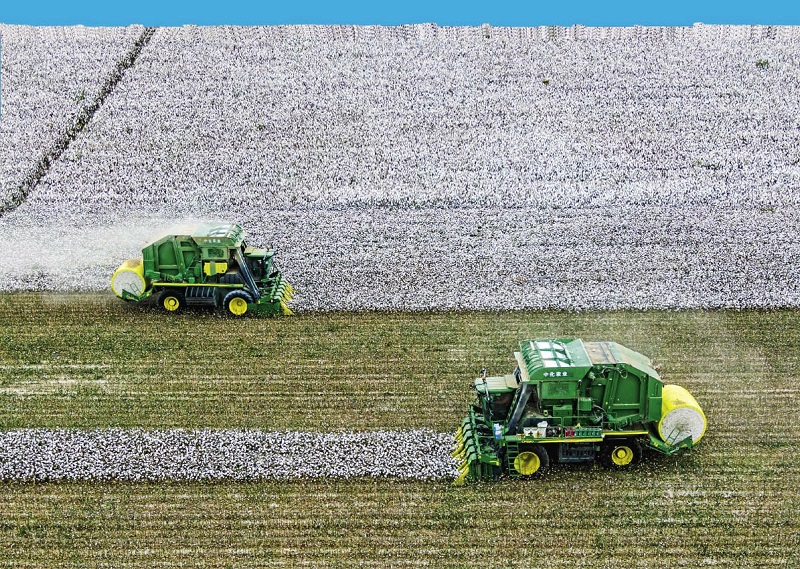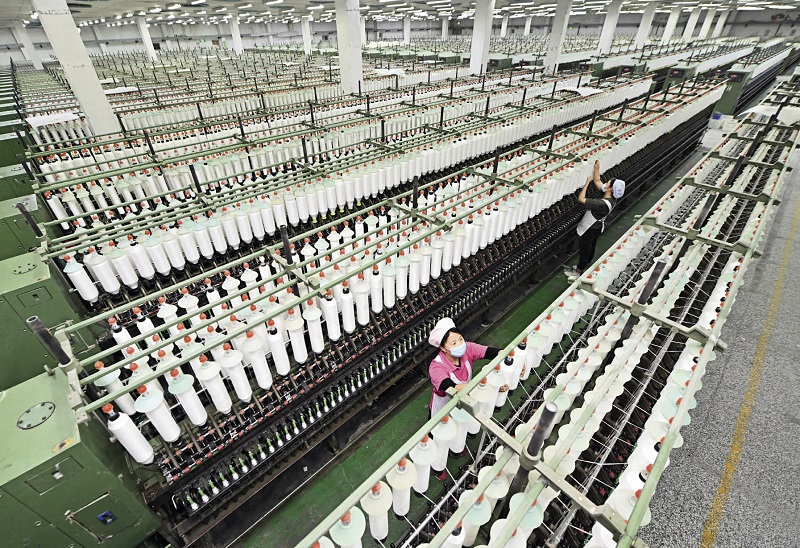Located in the northwest of China, Xinjiang Uygur Autonomous Region boasts long hours of sunshine and ample water for irrigation — making the region geographically ideal for growing cotton. Cotton grown in Xinjiang, which has good coloration and long fiber, is favored in both domestic and foreign markets.
In recent years, with an improving industrial chain, the cotton industry in Xinjiang has undergone rapid development and become the dominant industry in the region.

Two cotton pickers are busy harvesting cotton in Xinjiang on September 28, 2020.
Highly Mechanized Cotton Picking
Inside a production workshop of the Xinjiang branch of the China Railway Construction Heavy Industry Corporation Limited (CRCHI), workers are installing a 4MZ-6 intelligent cotton picker. This high-end mechanical cotton picker features strong power, high efficiency, safe operation, and easy-to-operate functions.
China is the world’s biggest cotton consumer and a big cotton producer. In 2020, its cotton output was about 5.95 million tons, of which Xinjiang produced 5.16 million tons, making up 87.3 percent of the total, according to data released by China Grain Reserves Group. Xinjiang began to use machines to harvest cotton in 2000. Mechanization was popularized in 2010 as the country offered subsidies to purchases of agricultural machineries. From 2015, the demand for mechanical cotton pickers grew robustly.
“Mechanical cotton pickers are highly efficient,” said Song Lixin, Party secretary and executive director of the Xinjiang branch of CRCHI. “A standard cotton picker is more efficient and can pick the equivalent of the harvest by 1,200 workers in the same period of time,” he said. Efficiency means a reduction in costs. In the past, local growers needed to pay cotton pickers RMB 2 per kg. By contrast, the cost of mechanized cotton harvest is only around RMB 0.4 per kg.
According to Song, the company entered the high-end agricultural machinery market in 2018 and began to sell agricultural machinery and equipment in bulks in 2019, recording great success in terms of both sales volume and product performance. In the 2020 harvest season, the average harvesting area of each mechanical cotton picker sold by the company reached 747 hectares. At present, one out of three cotton pickers in Xinjiang is produced by CRCHI.
An increasing amount of cotton is harvested by machines in Xinjiang. Data released by the Department of Agriculture and Rural Affairs of Xinjiang show that in 2020, the planting area of cotton picked by machines reached 1,126 hectares, accounting for 69.83 percent of the total. In north Xinjiang, the harvest of more than 95 percent of cotton fields was mechanized, while in the south the rate was also on the rise.
Independent R&D
The Chinese market of mechanical cotton pickers were previously dominated by foreign brands for many years. In recent years, with technological breakthroughs and independent innovation, domestic brands have gradually gained a large market share and boast equipment that is highly automated and smart.
Since its establishment in 2015, the Xinjiang branch of the CRCHI has set up its own research team and invested heavily in research and development. In 2018, an intelligent cotton picker, independently developed by the machinery maker, made its debut in the market. Equipped with a better engine, an advanced operating system, new features, and an intelligent control system, it is much more convenient and efficient.
In December 2020, another new product was launched. It is capable of picking up 93 percent of the cotton on the plant. Meanwhile, its electricity control system was based on another independent design. There is also an intelligent detection system, which can visually present the whole process of harvesting cotton including picking, gathering, packing and loading. The process can also be seen from a smart phone.
In addition to the CRCHI, there are half a dozen domestic brands in the Xinjiang market, such as Boshiran and Changzhou Dongfeng.
Now, the comprehensive performances of domestic cotton pickers have matched that of foreign machines. In the future, domestic brands are expected to grow bigger in size and more intelligent.

Two female workers carry out their daily responsibilities at the fine yarn workshop in Xinjiang Taichang Industrial Co., Ltd. on April 1, 2021.
Toward Intelligent Made in Xinjiang
As an important hub along the Belt and Road routes, and a core area of the Silk Road Economic Belt, Xinjiang has more to offer than cotton. Its unique geographical location attracts many textile enterprises to set up factories in the region. This further gave rise to the growth of local textile equipment makers, which ensured the smooth running of the entire cotton industrial chain.
Global leading textile machinery manufacturer Saurer set up a core factory in the Urumqi Economic and Technological Development Zone. The factory focuses on the production, R&D, and sales of intelligent textile equipment. As one of the world’s three major winder manufacturers, the company produces the entire range of equipment through the whole process from bale to yarn.
In the display area of the company’s Innovation and Technology Center, sophisticated smart textile machines including air-spinning machines and winder machines are in operation. Thick cotton strips are turned into yarn as thin as hair in a spinning machine, which can automatically reconnect broken pieces of yarn. The workshop that produces the high-end machinery is massive, but requires only a few workers. Thanks to the construction of the company’s Industry 4.0 Smart Factory, such a small number of people could keep the whole workshop running efficiently.
According to the manager of the manufacturing and engineering department surnamed Ma, behind the physical factory, there is an “intelligent brain” — an information technology system. It is made up of subsystems of data collection and monitoring, equipment interconnectivity, bulletin management, warehouse equipment control, and error prevention and correction. The subsystems work in tandem to ensure smooth data flow and production procedure.
“Every aspect of the manufacturing process is intelligent,” said Ma. “We can check on everything about an order — components it uses, the inventory and shipment of supplies — on the intelligent system. Besides, we have self-driving vehicles to send the supplies to designated areas via the smart logistics subsystem. There’s also an alert system to send abnormal parameters to engineers, and when in-house engineers cannot solve the problems, experts from all over the world can log onto a cloud system to fix them,” said Ma.
The intelligent manufacturing greatly improves the management of the factory and the quality and efficiency of the production of spinning machines. It also offers textile and garment enterprises down the industrial chain useful experience to draw on to improve their efficiency. At present, the factory is cooperating with Xinjiang University to explore the application of digital twin technology to make the factory more intelligent and boost the development of the cotton textile industrial chain in Xinjiang.